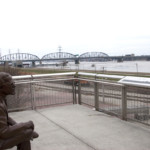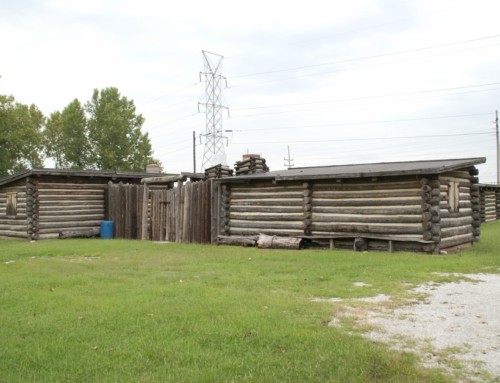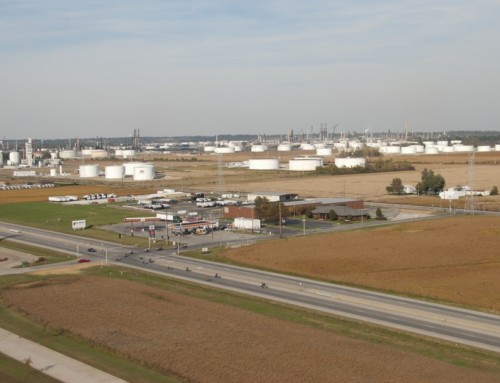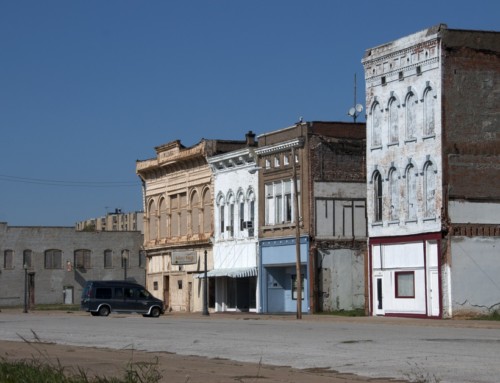Introduction
East St. Louis is often derided for its contemporary corruption (or perception of corruption), but the reality is that the city is in the shape it is today because of poor planning, exploitation by industrial interests, and corruption that began with the town’s founding. The East St. Louis of today is largely a product of decisions and actions made by its early political and business leaders.
Visitor Information
Get your questions answered by contacting the good folks at Explore St. Louis (800.916.8938).
History
In 1795, James Piggott inaugurated ferry service from St. Louis to the east bank of the river. Samuel Wiggins bought an interest in the ferry in 1819, and later persuaded the Illinois legislature to grant him a monopoly, which is a good part of the reason that the Wiggins Ferry Company stayed in business until the 1930s. In 1808, a small village called Illinois City was founded; a decade later it was platted as Illinoistown. In 1821, the small settlement had about a hundred residents. It didn’t have a great reputation in the region. In the mid-1800s, the Belleville Advocate described Illinoistown as “as a rough town of gamblers and vice with its disreputable floating population and its sink holes of iniquity where the moral filth of St. Louis could take refuge to plan its deeds of crime.”
Back when no bridges spanned the Mississippi River, railroads from the east coast terminated on the east bank of the river. The railroad industry, with its growing size and influence, pushed to create a new town at the site to advance their interests. They got their way in 1861 when Illinoistown and the town of St. Clair were combined into a new city with an unincorporated section that the railroads had been calling East St. Louis. Railroad tracks eventually covered a substantial area of the city and its streets. There was an old joke that East St. Louis never had a single bank robbery because the railroad tracks blocked all the escape routes.
The first mayor of East St. Louis was a lawyer with ties to the big transportation companies. He drafted incorporation papers, the city charter, and helped define the land boundaries. For the first twenty years, rich industrialists, most of them based in the East or North (Carnegie, Mellon, Gould, Morgan, Vanderbilt, Morris, Armour, Swift) battled with local merchants for control of the city government. Big business would win and, in the process, convince city politicians to keep regulation minimal and taxes low. Because the city’s industries paid next to nothing in taxes, East St. Louis relied on tavern licenses as its main source of revenue to provide city services.
In 1877, a disputed election resulted in two separate groups claiming victory. Unable to resolve the issue quickly, the town had two mayors, two city councils, and two police forces – for two years! The conflict erupted on June 30, 1878, when the two police forces shot at each other; two marshalls died in the fight. With a power struggle at the top of city government, fighting crime in the rest of the city was a low priority (which it was for much of the time, anyway).
In 1887, Monroe Stephens was elected mayor and presided over 22 years of relative calm and stability, at least by East St. Louis standards. His administration floated a bond issue for the construction of new roads that were supposed to be built high enough to remain dry during periods of flooding. Unfortunately, the construction costs were well beyond the city’s financial means, so East St. Louis could only afford to make interest payments on the bonds – for decades. It didn’t help that city officials stole money from the public coffers while accepting bribes from businesses and individuals– just businesses-as-usual in East St. Louis.
African American Migration to the City
African Americans from the south began migrating to East St. Louis after the Civil War. They formed a small community until the early 20th century, but managed to develop some political influence. As the labor movement grew and workers demanded better wages and working conditions, companies responded by recruiting more workers to move to East St. Louis. In some cases, the companies lured new immigrants to the area with the promise of jobs. Many companies also sent agents to the South to convince African Americans to move north, buying train tickets in bulk quantities and handing them out. The agents promised jobs with good wages, fair treatment, and short hours, but once African Americans reached East St. Louis they were left to fend for themselves.
Still, thousands of African Americans responded, which didn’t go over very well with many of the white residents. White factory workers got angry as African Americans earned money to buy homes and fix them up. By the mid-1910s, unions openly complained that companies were attempting to break unions by importing African Americans as replacement workers. Unfortunately, the unions directed their anger more strongly at the black workers than at the companies (most unions represented only white workers).
Newspapers inflamed tensions by writing stories that exaggerated the role of African Americans in criminal activity, and white elected officials fed into the hysteria. Politicians and business leaders colluded to keep African Americans in segregated neighborhoods; an African American could lose their job for living too close to a white neighborhood. Tensions rose as community leaders encouraged vigilante groups to drive African Americans out of town permanently. On May 28, 1917, violence erupted when news circulated that a robber who was African American had accidentally shot a white man. A crowd quickly assembled and demanded that the suspect be lynched. The mob hit the downtown streets, attacking any African American they encountered. The National Guard arrived and quelled the violence; although some African Americans had been severely injured, no one had been killed.
Tempers seethed under the surface for the next month. Black workers at the Aluminum Ore plant were frequently harassed and beaten. By the end of June, rumors were circulating that African Americans were preparing an armed attack on whites that would be executed on July 4. On the night of July 1, a couple of cars drove through black neighborhoods randomly firing shots into the homes of black residents. Residents grabbed their guns and prepared to defend themselves from another attack. When another car, identical to one of the earlier ones, drove through the same area, someone fired a few shots at the cars and the vehicles retreated. Unfortunately, the occupants of that car included two plain clothes police detectives, two uniformed police officers, and a reporter. The two plain clothes cops, Samuel Coppedge and Frank Wadley, were killed.
The next morning, their car was displayed in front of the police station, so everyone could see the bullet holes and blood-stained upholstery. A local attorney offered to represent anyone who would avenge their deaths. The attack on the detective’s car fueled fears of the rumored July 4 uprising. Mayor Fred Mollman requested National Guard troops, but the Governor only sent one company instead of the six the mayor expected. Around 10am on July 2, a mob of armed white residents marched downtown and attacked every African American they encountered, including women and children, and black-owned homes and businesses were set on fire. The mob regrouped downtown around 6pm and the chaos reached its peak—victims begging for their lives were maimed and killed or burned alive; some were hanged from street lamp posts.
Order was slowly reestablished as the National Guard arrived. The St. Louis Fire Department rushed to help the East St. Louis firemen quell the flames. St. Louis police were stationed on the Eads Bridge to prevent white rioters from crossing into Missouri. In the end, property damage was nearly $400,000 and some 300 homes and businesses were destroyed. The official death toll was eight whites and 39 African Americans, but it’s more likely that hundreds of people died in the rioting, almost all of them African American. Nearly 6,000 people were left homeless. Few white residents expressed regrets about the riot. The mayor’s personal secretary, Maurice Ahearn, was later indicted for conspiring with rioters and for ordering law enforcement to destroy cameras and photographic equipment so it was hard to document the damage. The 1917 East St. Louis riot remains one of the deadliest in US history.
Decline of Industrial Economy
Even with the abundance of factory jobs, East St. Louis never had a well-off population. By 1920, poverty was endemic: among US cities with at least 50,000 residents, East St. Louis was the second poorest. Employers kept wages low by flooding the market with cheap labor, either African Americans from the South or immigrants fresh in the country. In 1920, the annual income for a resident of East St. Louis was one-fourth of that for the average Illinois resident. Because of the number of low paying jobs, the city never really developed a middle class.
With few other sources of revenue, the city relied heavily on saloon licenses, which accounted for half of the city budget in some years. The saloons developed into havens for illegal gambling, prostitution, and bootlegging. The neighborhood between East St. Louis and National City had so many saloons that it was called Whiskey Chute. Illegal gambling persisted well into the 1950s, and brothels operated freely until the 1940s.
The brothels might have operated longer if not for World War II. During the War, nearby Scott Field had one of the highest rates of venereal disease in the United States. The Army was not keen on this and intervened by threatening to make East St. Louis off-limits to its soldiers if the city didn’t act. Fearing the loss of revenue from one of the city’s most important customer bases, the mayor reluctantly shut down the brothels.
East St. Louis also developed into a haven for organized crime, producing gangsters like Frank “Buster” Wortman who controlled a crime network from Peoria to Cairo. Criminal gangs first became established in the city by moving liquor during Prohibition and later expanded into gambling and prostitution; they also muscled their way into some labor unions.
The city’s population peaked in 1950 at 82,295 but decline set in swiftly as industries abandoned East St. Louis and its neighbors. In the 1950s, the Aluminum Ore Company laid off 25% of its workforce, and the Armour meat packing plant in National City closed a few years later. In the 1960s, job losses accelerated with the closing of American Zinc, Darling Fertilizer, and Swift’s meat packing plant.
Even as the US economy was going strong during the Vietnam War, unemployment in East St. Louis hit 21%. Not surprisingly, the residents began to follow the jobs out of the city. Between 1950 and 1970, the city lost 30% of its population; among the ones who remained, unemployment reached staggering levels – by the end of the 1960s, 36% of households did not have a single person employed. Declining revenues lead to substantial reductions in city services, and crime skyrocketed. The remaining fabric of the city was scarred when elevated highways cut through city neighborhoods and the riverfront.
Today, East St. Louis remains a struggling city with a declining population. Plans to help the city back on its feet never seem to gain traction and rarely attract the resources to make change possible. A casino has helped bring in jobs and revenue, but the city’s needs go far beyond what one casino can provide.
Exploring the Area
The Gateway Geyser in East St. Louis’ Malcolm Martin Memorial Park (185 Trendley Ave.) shoots off its impressive fountains at noon every day from May through September, if it’s not too windy. The biggest fountain shoots water 630 feet into the air, matching the height of the Gateway Arch across the river. The show lasts ten minutes. At the other end of the park, the Mississippi River Overlook has the best view of the Arch and downtown St. Louis.
The Katherine Dunham Museum in East St. Louis (618.795.5970) preserves the private art collection of the famed dancer, which features pieces from the Caribbean and Africa, as well as other places around the world; it is currently open for tours by appointment only.
Entertainment and Events
DraftKings at the Casino Queen (200 S. Front St.; 618.874.5000) offers a full range of gambling options, plus it has good views of the river and downtown St. Louis.
**East St. Louis is covered in Road Tripping Along the Great River Road, Vol. 1. Click the link above for more. Disclosure: This website may be compensated for linking to other sites or for sales of products we link to.
Where to Eat and Drink
You can get a bite to eat at DraftKings at the Casino Queen (200 S. Front St.; 618.874.5000), which has a casual buffet option as well as fine dining.
Where to Sleep
DraftKings at the Casino Queen (200 S. Front St.; 618.874.5000) manages a secured RV park that offers full hookups, as well as a full-service hotel with 157 rooms, some with great views of the river and St. Louis.
Resources
- East St. Louis Public Library: 5300 State St.; 618.397.0991.
- Post Office: 950 Missouri Ave.
Where to Go Next
Heading upriver? Check out Cahokia Mounds State Historic Site.
Heading downriver? Check out Sauget.
Community-supported writing
If you like the content at the Mississippi Valley Traveler, please consider showing your support by making a one-time contribution or by subscribing through Patreon. Book sales don’t fully cover my costs, and I don’t have deep corporate pockets bankrolling my work. I’m a freelance writer bringing you stories about life along the Mississippi River. I need your help to keep this going. Every dollar you contribute makes it possible for me to continue sharing stories about America’s Greatest River!
©Dean Klinkenberg, 2024, 2021, 2018,2013,2011
A Song for East St. Louis
East St. Louis Blues by Luella Miller (1928)






